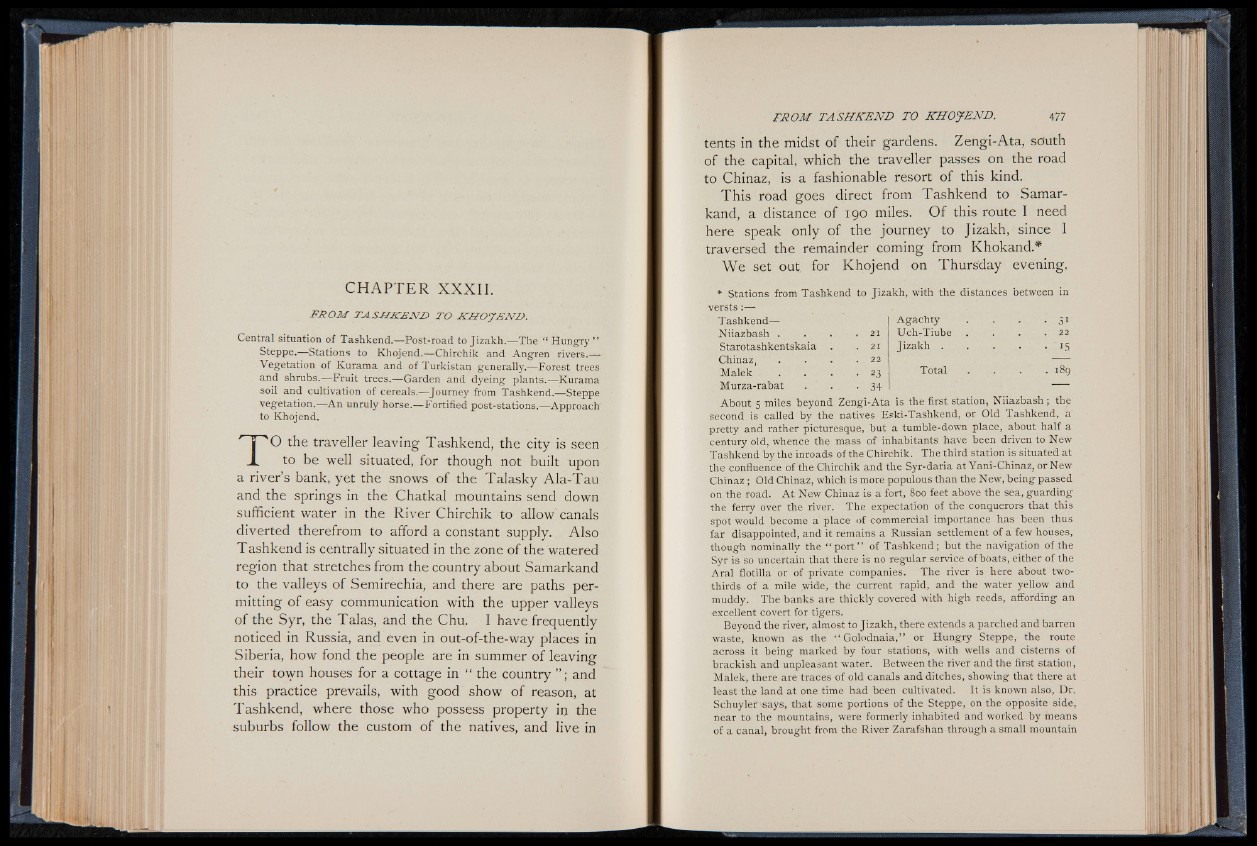
C H A P T E R X X X I I .
F R OM T A SH K E N D TO K H O JE N D .
Central situation of Tashkend.— Post-road to Jizakh.— The “ Hungry ”
Steppe.— Stations to K h o je n d C k i r c :hik and Angren rivers.— -
Vegetation of Kurama and of Turkistan generally.— Forest trees
and shrubs.— Fruit trees.— Garden and dyeing plants.— Kurama
soil and cultivation of cereals.— Journey from Tashkend.— Steppe
vegetation.— An unruly horse.— Fortified post-stations.— Approach'
to Khojend.
TO the traveller leaving Tashkend, the city is seen
to be well situated, for though not built upon
a river’s bank, yet the snows of the Talasky Ala-Tau
and the springs in the Chatkal mountains send down
sufficient water in the River Chirchik to allow’ canals
diverted therefrom to afford a constant supply. Also
Tashkend is centrally situated in the zone of the watered
region that stretches from the country about Samarkand
to the valleys of Semirechia, and there are paths permitting
of easy communication with the upper valleys
of the Syr, the Talas, and the Chu. I have frequently
noticed in Russia, and even in out-of-the-way places in
Siberia, how fond the people are in summer of leaving
their town houses for a cottage in “ the country and
this practice prevails, with good show of reason, at
Tashkend, where those who possess property iij the
suburbs follow the custom of the natives, and live in
tents in the midst of their gardens. Zengi-Ata, so'uth
of the capital, which the traveller passes on the road
to Chinaz, is a fashionable resort of this kind.
This road goes direct from Tashkend to Samarkand,
a distance of 190 miles. O f this route I need
here speak only of the journey to Jizakh, since I
traversed the remainder coming from Khokand*
We set out for Khojend on Thursday evening,
* Stations from Tashkend to Jizakh, with the distances between in
versts
Tashkend— A ga chty ■ - 3 1
Niiazbash . . 21 Uch-Tiube . 22
Starotashkentskaia . 21 Jizakh . • n
Chinaz, . . . 22 —
Malek • 23 Total . 189
Murza-rabat • 34 —
About 5 miles beyond Zengi-Ata is the first station, N iia zb a sh; the
second is called by the natives Eski-Tashkend, or Old Tashkend, a
pretty and rather picturesque, but a tumble-down place, about half a
century old, whence the mass of inhabitants have been driven to New
Tashkend by the inroads of the Chirchik. The third station is situated at
the confluence of the Chirchik and the Syr-daria at Yani-Chinaz, or New
Chinaz ; Old Chinaz, which is more populous than the New, b eing passed
on the road. A t New Chinaz is a fort, 800 feet above the sea, guarding
the ferry over the river. The expectation of the conquerors that this
spot would become a place of commercial importance has been thus
far disappointed, and it remains a Russian settlement of a few houses,
though nominally the “ p o rt” of Tashkend; but the navigation of the
Syr is so uncertain that there is no regular service of boats, either of the
Aral flotilla or of private companies. The river is here about two-
thirds of a mile wide, the current rapid, and the water yellow and
muddy. The banks are thickly covered with high reeds, affording an
excellent covert for tigers.
Beyond the river, almost to Jizakh, there extends a parched and barren
waste, known as the “ Golodnaia,” or Hungry Steppe, the route
across it being marked by four stations, with wells and cisterns of
brackish and unpleasant water. Between the river and the first station,
Malek, there are traces of old canals and ditches, showing that there at
least the land at one time had been cultivated. It is known also, Dr.
Schuyler says, that some portions of the Steppe, on the opposite side,
near to the mountains, were formerly inhabited and worked by means
of a canal, brought from the River Zarafshan through a small mountain